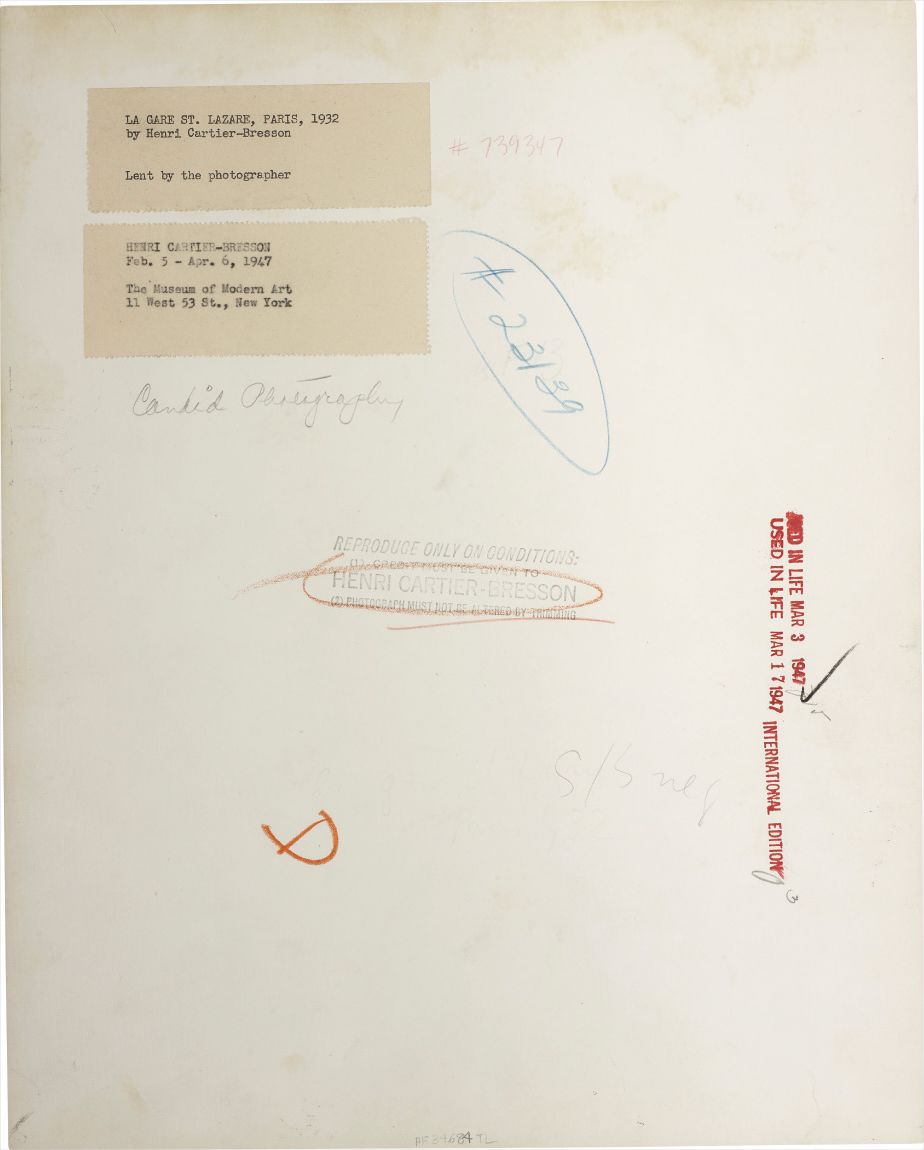



59
Henri Cartier-Bresson
Behind the Gare Saint-Lazare, Paris
Sheet: 35 x 28.3 cm (13 3/4 x 11 1/8 in.)
Full-Cataloguing
Henri Cartier-Bresson
In 1932, a young Henri Cartier-Bresson crouched behind the fence at Paris’s Saint-Lazare train station taking with his Leica camera what would become one of his most iconic images.
At this time Cartier-Bresson was involved in the Surrealist movement, attending their meetings and taking in their notions of the role of the camera and image-making. The Surrealists were enamoured with the relationship between the city and the camera. In his Second Surrealist Manifesto (1929) André Breton argued that the camera functions as a type of gun and that ‘the simplest Surrealist act consists in going into the street, with a revolver in your hand, and shooting at random as often as possible into the crowd.’ And this is what Cartier-Bresson did. When he was not travelling on assignment, he was wandering the streets of Paris hunting for images.
Clément Chéroux posits in the catalogue for the 2013 Pompidou retrospective that between 1929 and 1935, Cartier-Bresson was caught between the rigid teachings of André Lhote, whose academy he had attended in 1927, and the liberty demanded by the Surrealists, seeking to create images in that space between mastery and intuition. This was achieved by his process of frst selecting a graphically interesting background then waiting for something striking to move into the frame. This combination of rigorous composition and signifcant content was what he would later coin the ‘decisive moment’, a term borrowed from Cardinal de Retz, a 17th century French priest. The Surrealists regarded composition and chance as a duality, and for Cartier-Bresson, the appeal of Surrealism was located in this openness to chance. ‘It is to Surrealism that I owe my allegiance and because it taught me to let the camera lens delve into the detritus of the unconscious and chance.’
Cartier-Bresson was a prisoner of war during the Second World War until his escape in 1943, then worked for the French resistance where he was assigned to record the German occupation and retreat. On his return to Paris in 1944, he discovered that many people thought he had died, including Nancy and Beaumont Newhall, who were organising a posthumous exhibition for him in New York. Thrilled by the idea of showing previously unseen work, he helped prepare for the no longer posthumous 1947 MoMA exhibition, reviewing contact sheets and pasting 11 x 7 cm prints into a book he called Scrapbook. It was during this process that Behind the Gare Saint-Lazare was first discovered. Martine Franck explains in a handwritten letter, held at the Fondation Henri Cartier-Bresson, that ‘Henri Cartier-Bresson discovered this image of Gare Saint-Lazare in his contact sheets while preparing for his exhibition at MoMA in New York in 1945-1946’. According to Franck, Cartier-Bresson produced the first prints of Behind the Gare Saint-Lazare in New York at David (Chim) Seymour’s lab in 1946 or 1947.
As of this writing, only five early prints of this image, printed in 1946-47, are known. The present lot is a glossy, ferrotyped print used by LIFE magazine in March 1947 as a full-page reproduction alongside their praising review of the MoMA exhibition. This was the first time Behind the Gare Saint-Lazare was published. A small print used in Cartier-Bresson’s Scrapbook, showing the full frame and his cropping marks, resides at the Fondation Henri Cartier-Bresson. The Fondation also holds another print that is similar in size to the current lot. Another similarly sized print was sold at Christie’s Paris in the 2001 sale HCB: 100 photographies provenant de la Fondation Henri Cartier-Bresson (lot 13). The current location of the large format exhibition print, exhibited in 1947 at MoMA, is unknown.
Phillips Photographs extend our sincere thanks to Aude Raimbault at the Fondation Henri Cartier-Bresson and Tasha Lutek at the Museum of Modern Art for their assistance in our research.
Henri Cartier-Bresson
French | B. 1908 D. 2004Candidly capturing fleeting moments of beauty among the seemingly ordinary happenings of daily life, Henri Cartier-Bresson's work is intuitive and observational. Initially influenced by the Surrealists' "aimless walks of discovery," he began shooting on his Leica while traveling through Europe in 1932, revealing the hidden drama and idiosyncrasy in the everyday and mundane. The hand-held Leica allowed him ease of movement while attracting minimal notice as he wandered in foreign lands, taking images that matched his bohemian spontaneity with his painterly sense of composition.
Cartier-Bresson did not plan or arrange his photographs. His practice was to release the shutter at the moment his instincts told him the scene before him was in perfect balance. This he later famously titled "the decisive moment" — a concept that would influence photographers throughout the twentieth century.